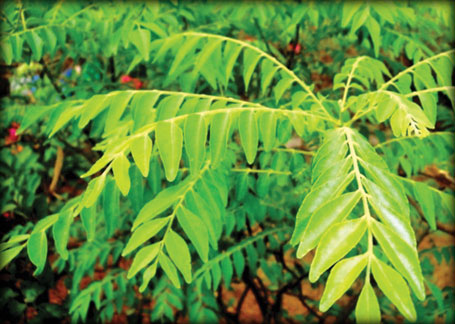Curry leaves: The tropical herb
by Shari Jayawardhana
The curry leaf is an essential ingredient in Sri Lankan cooking.
However, many of us simply remove and throw the leaf from our food since
it has already added its flavour and aroma to the cooked dish. It is
purely your choice whether you want to eat the leaves or not. But,
knowing about its health benefits will help you consume it at regular
intervals.
The curry tree (Murrayakoenigii) is a tropical to sub-tropical tree
which belongs to the family of Rutaceae, which is native to South Asian
countries such as Sri Lanka. The leaves are commonly called "Curry
leaves" and are used in various food preparations in Sri Lanka and
neighbouring countries. It is an aromatic shrub that grows abundantly in
the rich soils of Sri Lanka. It is a medium sized plant which grows up
to a height of about 3m. The leaves are distributed in 20-30 leaflets.
The leaves are slightly bitter and very aromatic.
The curry tree is another common herb that is cultivated in almost
all Sri Lankan home gardens. Curry leaves are shiny and dark green. It
is a staple in Sri Lankan cooking and is usually fried along with the
chopped onion, garlic and ginger in the preparation stage of most Sri
Lankan food.
 Curry leaf has many medicinal properties. It is a good digestive,
especially after consuming fried food. It aids in the treatment of
nausea, heartburn, morning sickness and other digestive disorders such
as diarrhoea, dysentery, vomiting and haemorrhoids. Curry leaves are
also known to improve eyesight, so make sure you do not throw away the
leaves while eating. If you don't like its raw taste, you can buy the
curry leaf powder widely available in the market and add it to curries
and other dishes. Curry leaf has many medicinal properties. It is a good digestive,
especially after consuming fried food. It aids in the treatment of
nausea, heartburn, morning sickness and other digestive disorders such
as diarrhoea, dysentery, vomiting and haemorrhoids. Curry leaves are
also known to improve eyesight, so make sure you do not throw away the
leaves while eating. If you don't like its raw taste, you can buy the
curry leaf powder widely available in the market and add it to curries
and other dishes.
Curry leaves have found to halt the progression of many
non-communicable diseases such as diabetes, cancer and heart disease.
Studies on curry leaves have shown that they can help in controlling the
blood glucose levels. The incidence of cancer has increased in Sri
Lanka. Though, there are effective treatments available to reduce
cancer, the side effects of the treatments such as chemotherapy and
radiation therapy can also be troublesome.
Research on the extracts of curry leaves has shown a reduction in the
side effects of both chemotherapy and radiation therapy. The
antioxidants present in curry leaves help in controlling the LDL or bad
cholesterol and aid in increasing the HDL or good cholesterol levels.
Curry leaves are also good for hair growth and in preventing premature
greying of hair. Many people do not like the taste of the curry leaves,
so eating it on a daily basis to get shiny black hair is not a practical
solution. But, you can prepare a hair tonic and use it on a daily basis.
Boil the leaves in coconut oil for a few minutes. You will notice
that your hair tonic takes a blackish tint. Use the hair tonic every
night before going to bed. Wash your hair the next morning with lukewarm
water and a mild shampoo.
Curry leaves are rich in calcium, phosphorus, iron, and vitamins A,
B, C and E. Alkaloids present in curry leaves are believed to have
antioxidant properties. The herb is a good blood purifier and a
restorative of the degenerated blood cells. Taken regularly, it has the
ability to build up and strengthen the liver. It is also a good tonic
for the spleen and pancreas. It may also be used as a poultice to treat
burns, bruises, cuts, skin eruptions and insect bites. The oil of the
curry leave is also believed to be an effective insect repellent.
Since curry leaves lose their fragrance after drying, they are best
used fresh. Instead of going for dried leaves, try growing your own
plant in a small pot.
Hot and dry conditions are the best way to grow this plant. They
don't have a long shelf life and thus should be wrapped in a moist
kitchen towel or newspaper and then stored in the refrigerator. Remove
the leaves from the stem only before cooking.
Curry leaves are used as the base in almost all Sri Lankan dishes.
Curry leaves are used as the key ingredient in making sambol, Herbal
Porridge (Kola Kanda) and chutney, to name a few. Many international
pharmaceutical companies use the raw ingredient to make capsules that
promote digestion.
Tea made out of curry leaves have also been introduced in the local
and international markets. It is also used by the Health and wellness
industry to manufacture essential oils for aromatherapy as well as hair
and skin care products.
By creating a renewed awareness on local herbs such as the "curry
leaves" it is hoped that the public will not only cultivate this
exquisite herb in their gardens but also consciously consume it to avail
one's self of its many health benefits.
|

